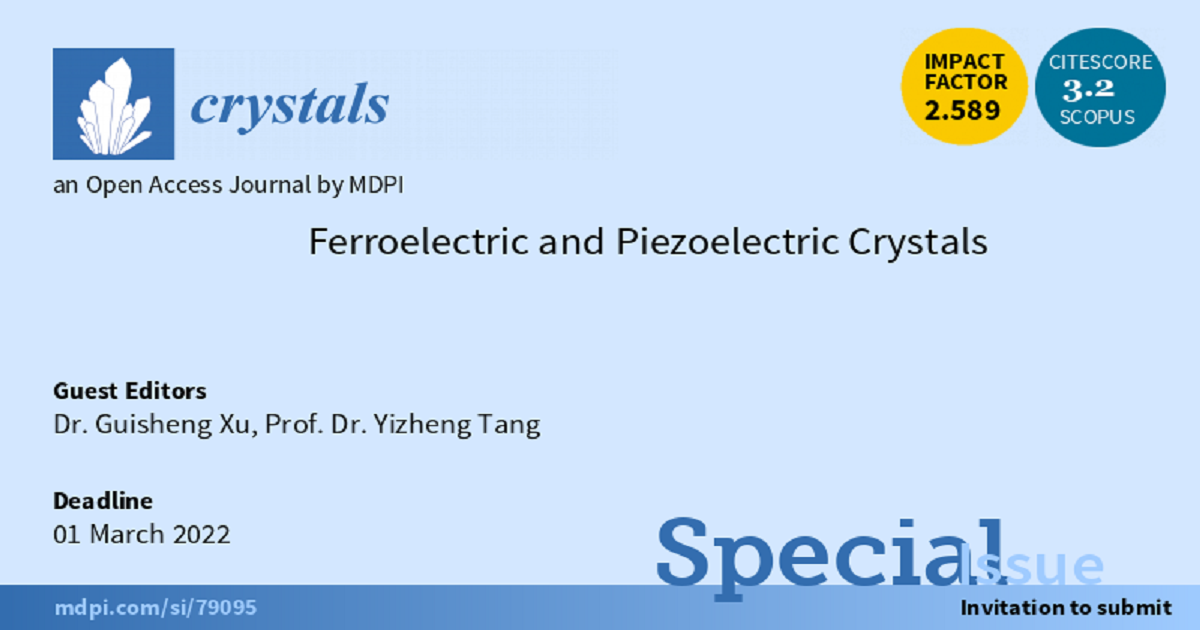Ferroelectric and Piezoelectric Crystals
A special issue of Crystals (ISSN 2073-4352). This special issue belongs to the section "Materials for Energy Applications".
Deadline for manuscript submissions: closed (15 August 2022) | Viewed by 21142

Special Issue Editors
Interests: crystal growth; synthetic crystals; ferroelectric materials; piezoelectric materials
Interests: ferroelectric materials; piezoelectric materials
Special Issue Information
Dear Colleagues,
Ferroelectric and piezoelectric single crystals, such as the solid solution crystals between a lead magnesium (zinc) niobate and lead titanate, have attracted a great deal of attention in the last few years for their extremely large piezoelectric strains and very high electromechanical coupling factors. In particular, the research and development in this area has advanced at an unimaginable rate in recent years. This issue is aimed at providing an update on the state of the art in this exciting field, including that on crystal growth, performance optimization and major piezoelectric applications.
Briefly, crystal quality has improved, and crystal size has grown, due to advancements in crystal growth technique. For example, modification in the temperature field and growth parameters of a Bridgman method has helped to produce huge-sized crystals with as large as 5-inch diameters, while the continuous-feeding Bridgman method has led to the occurrence of crystals with high composition and property uniformity.
Notable enhancement of performance, as higher piezoelectric strain, higher or lower mechanical quality factor Qm, and better temperature stability of ferroelectric and piezoelectric single crystals has been realized through material composite, rare earth doping, AC poling, domain engineering and microstructure adjustment. Meanwhile, the full set of material properties can be gained conveniently and self-consistently by using only one to two crystal samples.
The outstanding performance of these crystals makes them the primary candidates for the next generation of transducers, sensors, actuators and so on, and some significant progress in the devices based on the unique performances of relaxor-based single crystals will also be presented in this issue.
Dr. Guisheng Xu
Prof. Dr. Yizheng Tang
Guest Editors
Manuscript Submission Information
Manuscripts should be submitted online at www.mdpi.com by registering and logging in to this website. Once you are registered, click here to go to the submission form. Manuscripts can be submitted until the deadline. All submissions that pass pre-check are peer-reviewed. Accepted papers will be published continuously in the journal (as soon as accepted) and will be listed together on the special issue website. Research articles, review articles as well as short communications are invited. For planned papers, a title and short abstract (about 100 words) can be sent to the Editorial Office for announcement on this website.
Submitted manuscripts should not have been published previously, nor be under consideration for publication elsewhere (except conference proceedings papers). All manuscripts are thoroughly refereed through a single-blind peer-review process. A guide for authors and other relevant information for submission of manuscripts is available on the Instructions for Authors page. Crystals is an international peer-reviewed open access monthly journal published by MDPI.
Please visit the Instructions for Authors page before submitting a manuscript. The Article Processing Charge (APC) for publication in this open access journal is 2100 CHF (Swiss Francs). Submitted papers should be well formatted and use good English. Authors may use MDPI's English editing service prior to publication or during author revisions.
Keywords
- ferroelectric and piezoelectric single crystals
- crystal growth
- performance optimization
- property characterization
- transducers
- hydrophone
Benefits of Publishing in a Special Issue
- Ease of navigation: Grouping papers by topic helps scholars navigate broad scope journals more efficiently.
- Greater discoverability: Special Issues support the reach and impact of scientific research. Articles in Special Issues are more discoverable and cited more frequently.
- Expansion of research network: Special Issues facilitate connections among authors, fostering scientific collaborations.
- External promotion: Articles in Special Issues are often promoted through the journal's social media, increasing their visibility.
- e-Book format: Special Issues with more than 10 articles can be published as dedicated e-books, ensuring wide and rapid dissemination.
Further information on MDPI's Special Issue polices can be found here.





